In reply to NickD :
Interestingly, I just saw a video about the Keeler Branch of the C&C, and specifically its relationship with Cerro Gordo. Apparently one of the engines is being restored.
In reply to NickD :
Interestingly, I just saw a video about the Keeler Branch of the C&C, and specifically its relationship with Cerro Gordo. Apparently one of the engines is being restored.
In reply to 02Pilot :
SP #18 was returned to service in 2017 and has toured around on a couple different lines. The #8 is on display in Sparks, Nevada, and the #9 is on display at Laws, California. There was also a GE 50-ton diesel that SP purchased in 1954 and largely relegated the steam engines to backup power, but I don't know what happened to that.
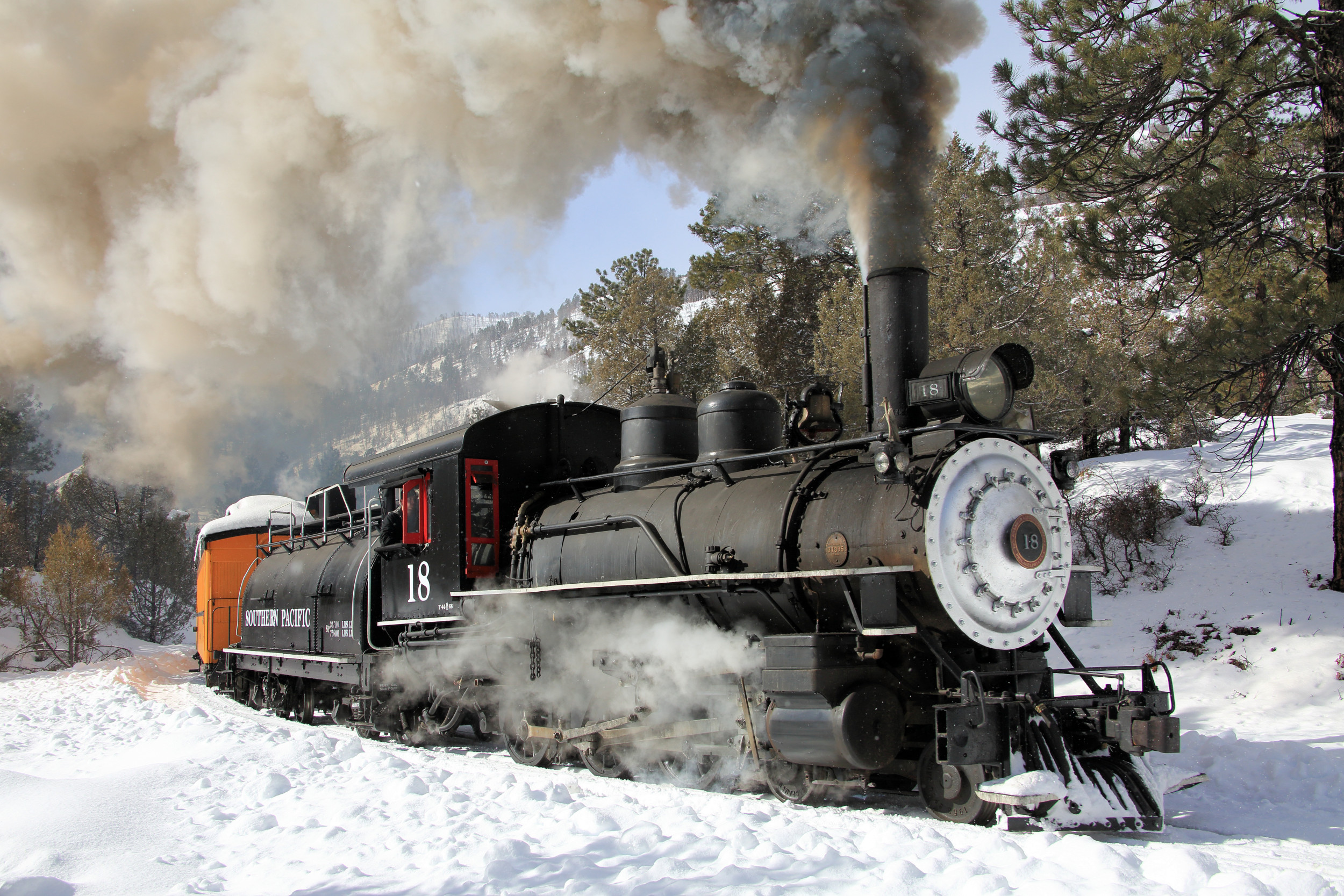
Southern Pacific #22 nears Keeler, CA, with a freight in May of 1940. The Ten-Wheeler was originally Florence & Cripple Creek No. 22, an 1899 product of Schenectady, and then became Nevada-California-Oregon No. 22 before the equipment was relettered for the SP.
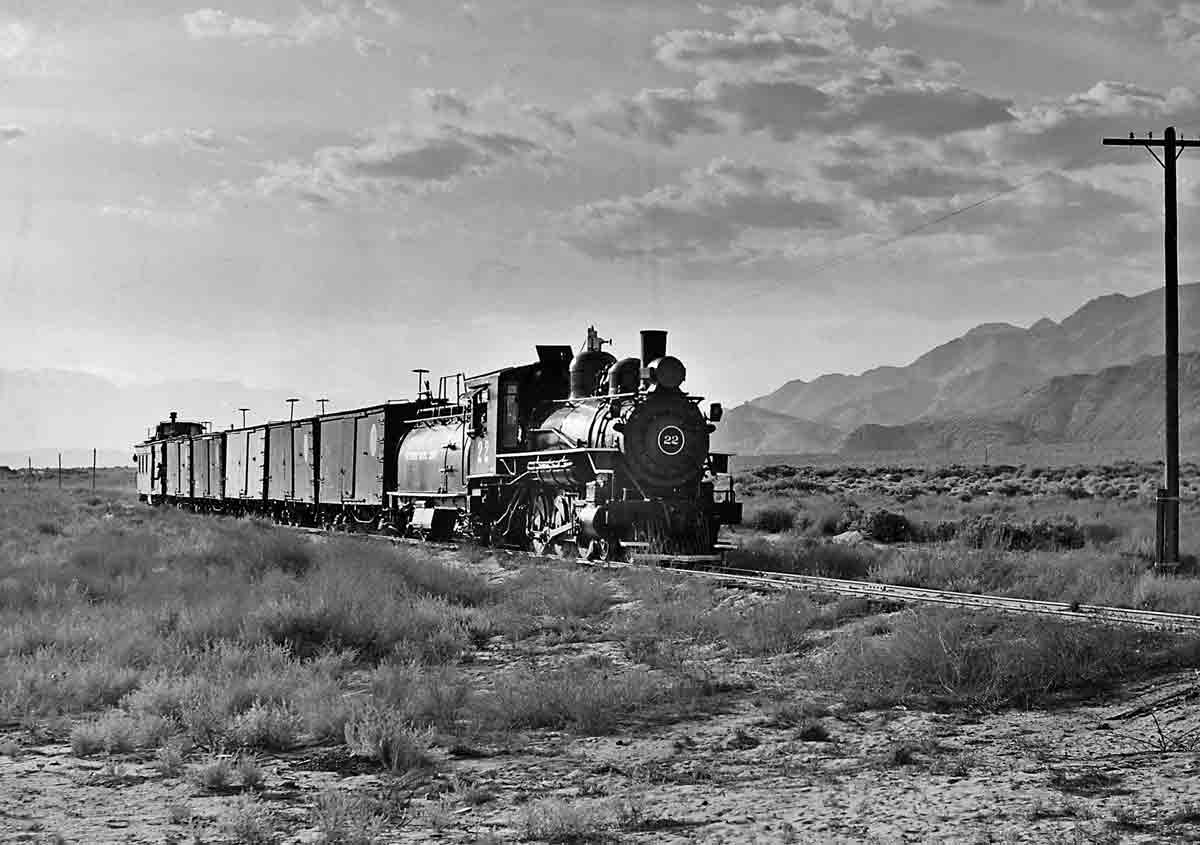
The whaleback tender was largely restricted to Southern Pacific, although Rock Island had a few Pacifics with them. Fortunately they never really seemed to catch on anywhere else because they were ugly as sin.
Behind an SP MM-2 class 4-6-6-2 Cab-Forward

A Pacific Electric 0-6-0 with a whaleback. PE was an SP subsidiary and used hand-me-down SP steamers.
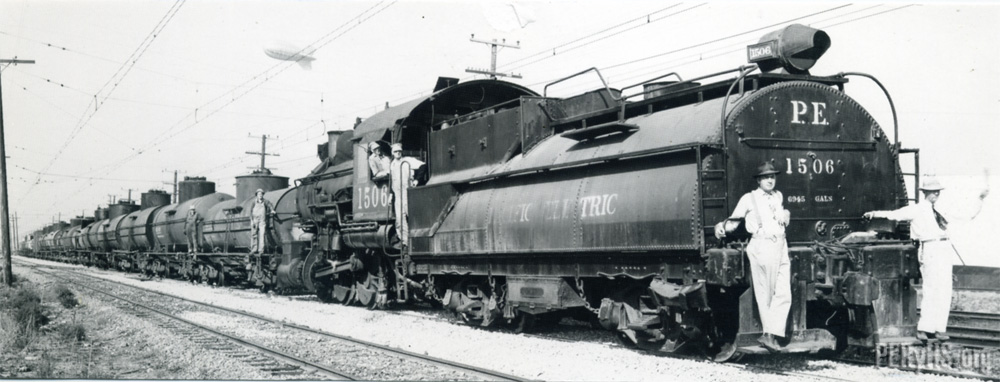
The much-maligned SP 2-8-4s. These had been the weird Boston & Maine T-1 Berskhires with the Coffin external feedwater heaters. During WWII, B&M foisted them off on SP and ATSF, who were in a power pinch. SP then yanked the Coffin feedwater heaters off and mated them to whaleback tenders off of retired Cab-Forwards to make them even stranger in appearance.

A really strange photo of an SP 4-4-2 with a whaleback tender acting as a helper to a GS-class 4-8-4. The blackout shroud over the headlight is also worth pointing out, dating this photo to either during WWII or just afterwards.
Boston & Maine had to have been pretty pleased with themselves when they somehow unloaded those Berkshires off on ATSF and Southern Pacific. B&M had never been happy with them, and they lived pretty short lives out west too, indicating they didn't do much better out there. Still equipped with the Coffin feedwater heater and the original tender, SP #3509 takes a drink at Deming, NM in 1947.

Of the seven that they ended up with, #4193-#4199, ATSF had one that they pretty extensively modified. They centered the headlight, relocated the bell, applied ATSF-style numberboards, swapped out the Coffin feedwater heater for an Elesco, raised the boiler pressure to 270 psi, replaced the Baker valve gear with Walschaerts, cast new smaller 27" diameter and longer 32" stroke cylinders, replaced the alligator crossheads with multiple-bearing crossheads,. The new combination of boiler pressure and cylinder volume raised tractive effort to a calculated 84,980 lb. But it apparently didn't warrant replicating on the other six, and the #4197 didn't outlast them either.
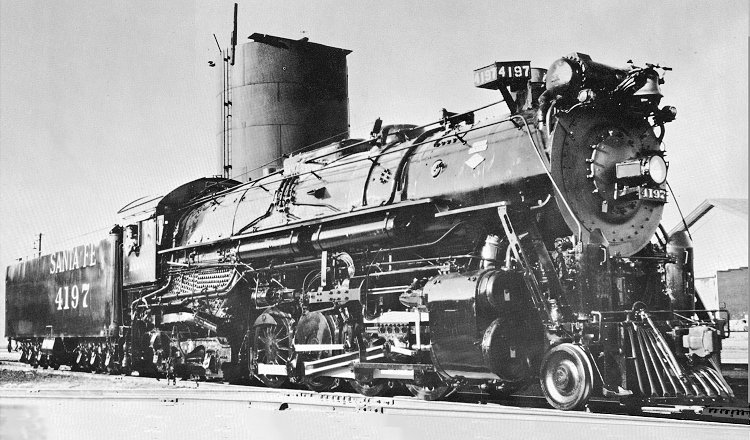
B&M kept 8 of the T-1 Berkshires, and #4023 was one of those. This photo was taken at the Boston coaling tower in 1948

I've never found an exact reason why the B&M T-1s were equipped with external Coffin heaters from the Lima plant. External Coffin feedwater heaters weren't extremely rare, but almost every time they were applied to an engine, it was due an older engine being retrofitted with a feedwater heater and there simply wasn't room to tuck a Coffin internal feedwater heater inside the smokebox. Examples of this would be the Central Vermont 4-6-0s and 2-8-0s or some of the Duluth, Winnipeg & Pacific's 2-8-0s. But the B&M engines were equipped with an external heater from the factory, which was odd. The theory I've seen is that, since these were mechanical duplicates of the Lima prototype Berkshire built for Boston & Albany and Illinois Central's 7000-series Berkshires, they were originally supposed to be equipped with Elesco feedwater heaters. But tight clearances in Hoosic Tunnel wouldn't allow for the big Elesco bundle-type feedwater heaters hanging out past the boiler, so they decided to use a Coffin feedwater heater (Boston & Maine seemed to prefer Coffin heaters, since their Mountains and Pacifics were all equipped with internal Coffin feedwater heaters). Since the boiler package wasn't designed for an internal feedwater heater inside the smokebox, the easiest solution was to just hang it out past the smokebox front, giving the T-1s their distinctive look.

The original Berskhire prototype, Lima Locomotive Works #1, on the scales at the Lima factory. Lima had modified a Mikado for the New York Central to test, resulting in the H-10 class. On their own, Lima continued to tinker with the design, eventually adding a 4-wheel trailing truck to enlarge the firebox, and when in 1926 the New York Central Systems needed faster and more powerful freight engines for the Boston & Albany, Lima built the #1 and sent it out to test on the B&A. The #1 did it's job and convinced the B&A to purchase twenty-five identical machines, class A-1. They did not purchase the #1 though, which then went out and tested on the Illinois Central. That same year, Illinois Central also purchased 50 identical 2-8-4s, #7000-#7049, and then also purchased the #1 and renumbered it to #7050. Two years later, Boston & Maine purchased the twenty-five T-1s which were mechanically very similar to the #1, the B&A A-1s, and the Illinois Central 7000s.
What was particularly baffling was the wildly different opinions of what were essentially the same machines. Boston & Albany was enamored with theirs, and went on to own 55 of them, crediting them with having plenty of power, speeding up traffic, being more efficient on fuel, and stated that the weirdo Lima articulating trailing truck "seemed to adapt itself very well to the track conditions. The engine rode steadily up to the highest operating speeds which the service required." Meanwhile, the Illinois Central seemed to absolutely loathe theirs, with one report stating that they "rode poorly above 40 mph, sometimes so roughly that the reverse gear wheel would suddenly spin into full forward gear. When that happened the throttle had to be closed at once and the valve gear returned to the proper position, and several engineers broke an arm doing so." They also complained that the Lima articulating trailing truck was prone to derailing, especially on reverse moves with a load. IC was so dissatisfied that they converted one to an even more disastrous light freight 4-6-4 Hudson, and then decided to thoroughly overhaul and modify the remaining 7000s, completely obliterating #7050's identity as the original demonstrator. Boston & Maine didn't complain about poor ride quality, but they thoroughly hated the Lima articulated trailing truck as well, finding the T-1s to be very slippery on starting, prone to derailing, and having issues with the firebox sealing due to the way the trailing truck was attached. B&M couldn't rid themselves of 17 of them fast enough when the opportunity arose.

Lima Locomotive Works #1/Illinois Central #7050 after the extensive 1939 rebuild program that the Paducah shops performed to the remaining 50 Berkshires (one of them was rebuilt into the unsuccessful freight Hudson in 1937). Among the changes made were the replacement of the Elesco feedwater heaters with Worthingtons, decreasing cylinder diameter an inch, increasing boiler pressure by 25psi, removing the trailing truck booster, backfitting the old-style Type A superheaters in place of the Type E superheaters they came with, and changing the spring equalizing to put more weight on the drive wheels and less on the trailing truck. The Berskhires were also heavily visually altered in the process. The headlight and smokebox door were centered up on the front, the footboards and small pilots were replaced with the weird corrugated pressed steel pilots that IC was partial to, the bell was moved up to the top of the smokebox, and the damn boxy sand dome that was an IC trademark was installed. The #7050 was pretty much unrecognizable as the same engine after the rebuild, and was renumbered to #8049.
For the record, Illinois Central didn't actually call a 2-8-4 a Berkshire. IC officially referred to the wheel arrangement as a "Lima" but crews were said to call tehm "Big Mikes." This is oddly similar to C&O, who called their 2-8-4s a "Kanawha" in company literature, but were also referred to as "Big Mikes" by crews.



Illinois Central #1, later numbered #2499, was the "Lima" that they rebuilt into a 4-6-4, which was the only 4-6-4 in North America intended specifically for hauling freight. Illinois Central was dissatisfied with the performance of the 7000s, and had the idea of "right-sizing" motive power for fast freight trains. Lima #7038 was the (un)lucky guinea pig for this experiment, but internal documents suggest that IC intended to rebuild all 50 remaining 7000s into the freight 4-6-4s, had the first one been a success. Debates exist whether IC reused the entire boiler or just the firebox, but the cab, cylinders, tender, and trailing truck were definitely all reused. The 63" spoked drivers were replaced with 73" Boxpok disc drivers, an unusual outside-journal front truck was installed, and it also received the cosmetic changes that the rebuilt 7000s received (centered smokebox door, centered headlight, corrugated pressed-steel pilot, IC rectangular sand dome). Because the #7038 was part of the last twenty 2-8-4s delivered to Illinois Central, it already came with a Worthington feedwater heater, instead of the Elescos that the first 30 were equipped with.
The #1 was immediately discovered to be a very slippery machine. Between having more non-powered axles than drive axles, cylinders sized for powering an 8-coupled engine attached to three axles, and some issues with the spring rigging that equalized the weight poorly, it immediately made a poor impression. John McIntyre, road foreman of engines at Clinton, IA, tried to solve some of #1's problems. His rebalancing of the equalizing system to reapportion the weight on the drivers seemed to help, but it wasn't until the Clinton shops fitted new 24.5" cylinders in place of the original 27" cylinders that the Factor of Adhesion became anywhere near reasonable. By that point, it had proven itself to be so disappointing that Illinois Central had instead embarked on the modification program that left the 7000s' wheel arrangement alone but fixed various other issues. The #1 was renumbered to the #2499 in 1945, and then retired and scrapped in 1950.

An Illinois Central 4-6-2 that was rebuilt at Paducah with 61" drivers, in place of the original 75" drivers, for use in local freight service.
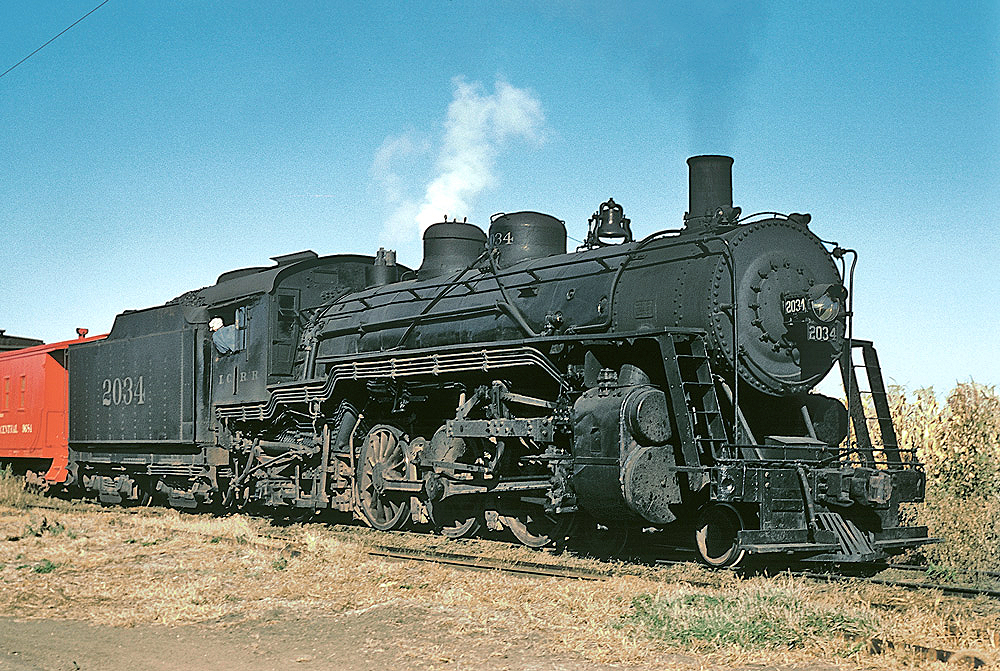
Similar to how they called the 2-8-4s "Limas", Illinois Central preferred to call their 2-10-2s "Centrals" instead of the more common "Santa Fe". Delivered in 1921 and constructed by Lima, Illinois Central owned 125 of them. Over the years, Illinois Central's Paducah shops made a number of various improvements, including mechanical lubricators, lightweight pistons, Boxpox drivers, new furnace bearers and square sand boxes, along with experiments with trailing truck boosters and raised boiler pressures. They also served as building blocks for other new locomotives, with the majority of them being used to construct 4-8-2s, 0-10-0s, 2-10-0s, and 2-8-2s. The #2911 was one of the ones that was not converted into another new locomotive, and had new brand-new boilers installed in 1944.
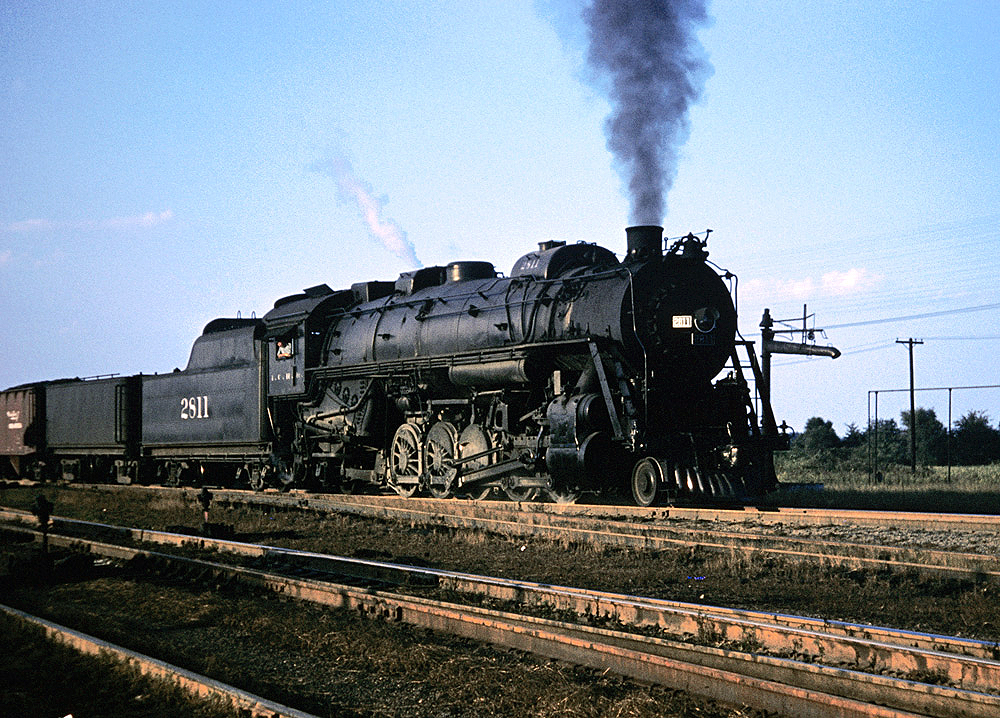
Illinois Central 2-8-2 #2199 on the deadline at Clinton, Illinois. This was a one-of-a-kind locomotive. The Illinois Central's extensive Paducah rebuilding program remodeled many 2-8-2s using cylinders and running gear from 2-10-2s. However, #2199 received its frame and running gear from Lima 2-8-4 #7038, which had given up its boiler to create the IC freight 4-6-4 #1 (later #2499). The hybrid #2199 began life in 1937 as #2020 and was renumbered in 1942. It had 27½x30-inch cylinders and 63½-inch drivers, and its boiler, originally from 1914-built 2-8-2 #1549, made 225psi. 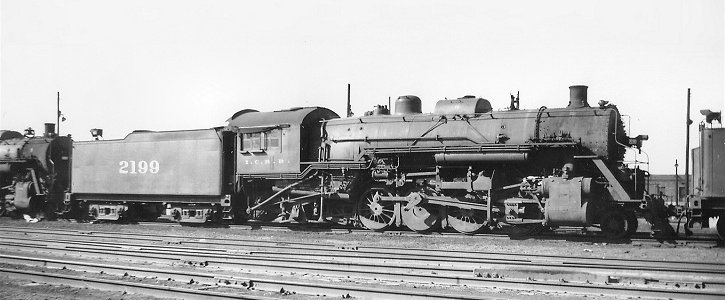
One of the Illinois Central's 2500-series Mountains. Between 1937 and 1942, Illinois Central built 55 of these using the boilers from the 2900-series 2-10-2s on a new cast one-piece frame, with 70" drivers and 30"x30" cylinders. With a total weight of 629,000lbs and almost 79,000lbs of tractive effort, these were big, powerful engines, surpassed only by Frisco's 4400-series 4-8-2s, which were coincidentally also built from 2-10-2s. The Illinois Central 2500s were unfortunately cursed with the IC cosmetic treatment of that dumb sand dome, the corrugated pressed-steel pilot, and unshielded air pumps on the pilot deck, which led to IC locomotives being ranked as among the least photogenic in the US.

The IC built a batch of 15 Decapods in 1939 that mated the frames, cylinders, and running gear from a 2900-series Central-type and the boiler package off a 1500-series Mikado. The 63" drivers off the Lima were fitted with thicker drivers to bump the diameter up to 64.5", which I believe made them the tallest drivered 2-10-0s around.

Illinois Central #2135 at Peoria, IL. Concurrent with the conversion of the 2-10-2s to 4-8-2s, the Paducah shops modified the frames from the 2-10-2s and used the cylinders and driving wheels along with new boilers to construct a total of forty-one 2-8-2s. They were built between 1937 and 1942 and numbered 2100 through 2140. The cylinders of the first 30 of the shop-built Mikados were bushed down to a 28" diameter and the other eleven were out shopped with the same 30" diameter cylinders that were on the 2-10-2s. These locomotives incorporated many of the same design improvements that had been added to the fleet of other 2-8-2s over the years.

Illinois Central #2613 on the Cairo Turn local freight at Carbondale, Illinois in December of 1959, with the injector cut in judging by the spray of steam near the trailing truck. The #2613 was one of the last active IC steam engines, even hauling an excursion for the L&N's centennial, since there were no active L&N steam locomotives. The #2613 hung around for a while after and was offered to the Kentucky Railway Museum, but they turned it down for lack of room. The KYRM board is said to have always regretted passing on the opportunity. The #2613 was part of the 2600-series Mountains, which were mechanically identical to the 2500-series Mountains but we're clean sheet builds. They also had a larger tender, since the 2500s frequently had to be paired with auxiliary canteens.

You'll need to log in to post.